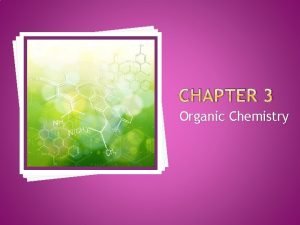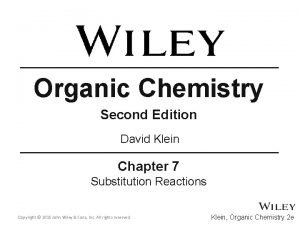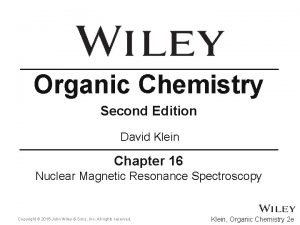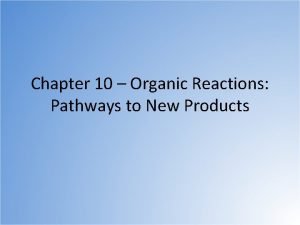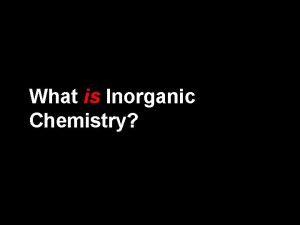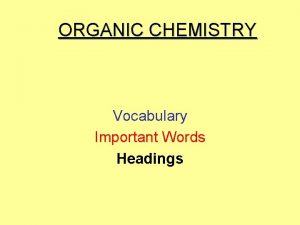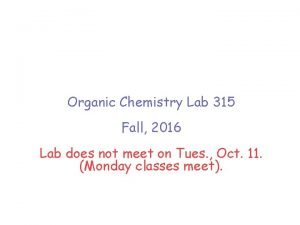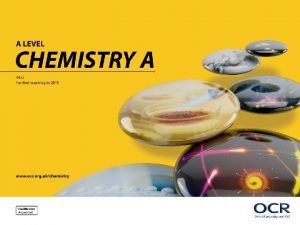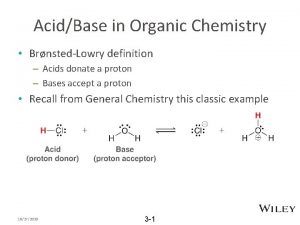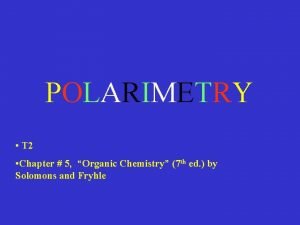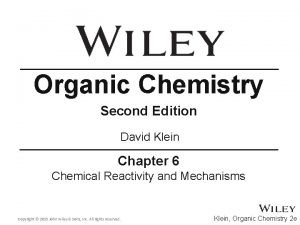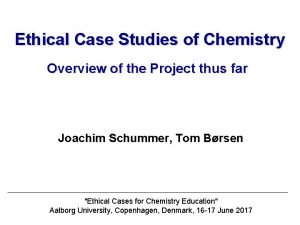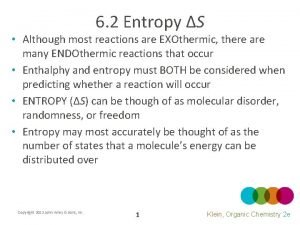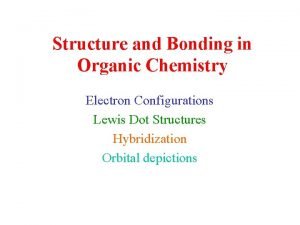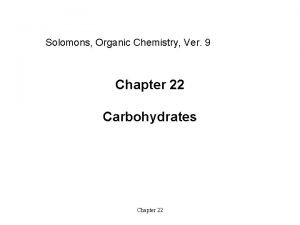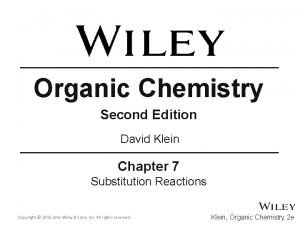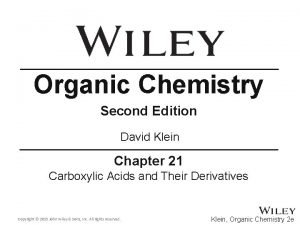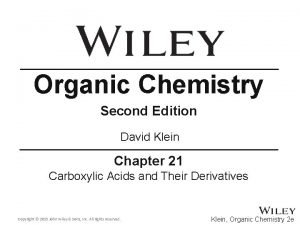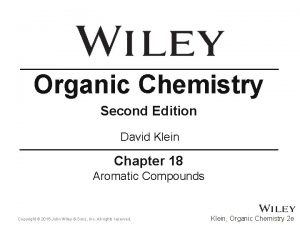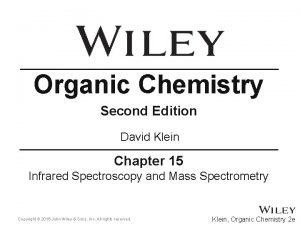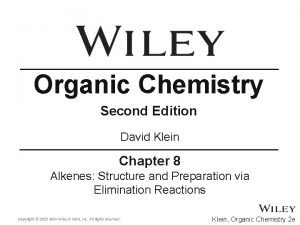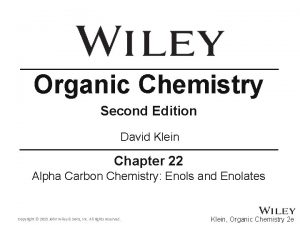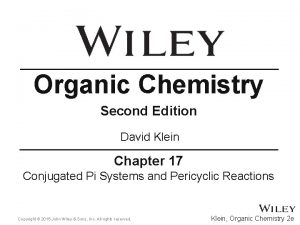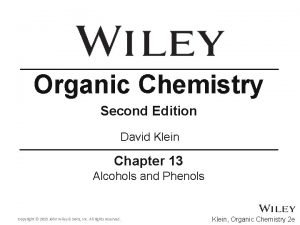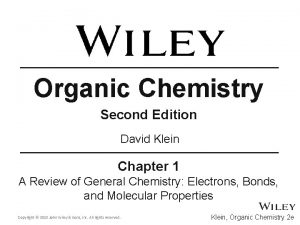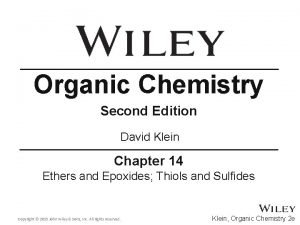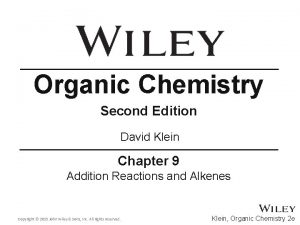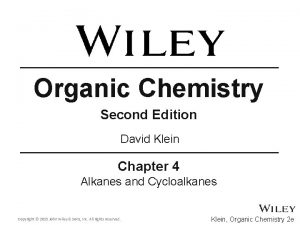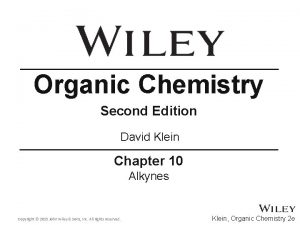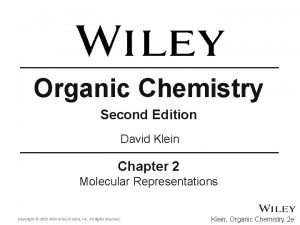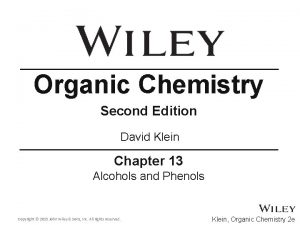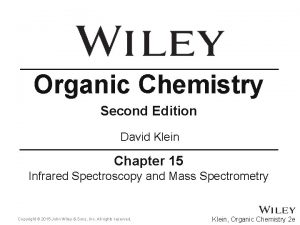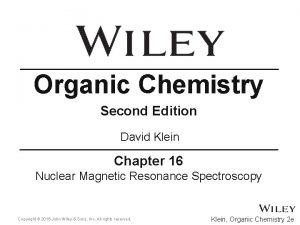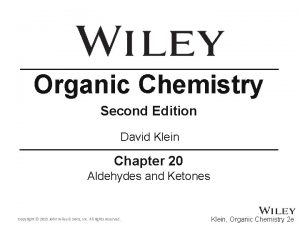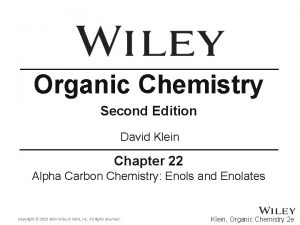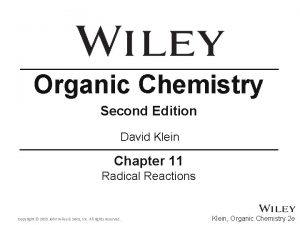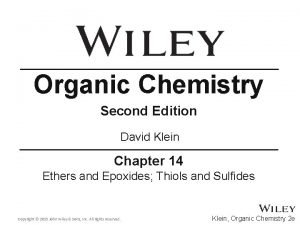Organic Chemistry Second Edition David Klein Chapter 18





























































- Slides: 61

Organic Chemistry Second Edition David Klein Chapter 18 Aromatic Compounds Copyright © 2015 John Wiley & Sons, Inc. All rights reserved. Klein, Organic Chemistry 2 e

18. 1 Introduction to Aromatic Compounds • Aromatic compounds or arenes include benzene and benzene derivatives • Many aromatic compounds were originally isolated from fragrant oils • However, many aromatic compounds are odorless • Aromatic compounds are quite common Copyright © 2015 John Wiley & Sons, Inc. All rights reserved. 18 -2 Klein, Organic Chemistry 2 e

18. 1 Introduction to Aromatic Compounds • 8 of the 10 best-selling drugs have aromatic moieties Copyright © 2015 John Wiley & Sons, Inc. All rights reserved. 18 -3 Klein, Organic Chemistry 2 e

18. 1 Introduction to Aromatic Compounds • Coal contains aromatic rings fused together and joined by nonromantic moieties Copyright © 2015 John Wiley & Sons, Inc. All rights reserved. 18 -4 Klein, Organic Chemistry 2 e

18. 2 Nomenclature of Benzene Derivatives • Benzene is generally the parent name for monosubstituted derivatives Copyright © 2015 John Wiley & Sons, Inc. All rights reserved. 18 -5 Klein, Organic Chemistry 2 e

18. 2 Nomenclature of Benzene Derivatives • Many benzene derivatives have common names. • For some compounds, the common name becomes the parent name. Copyright © 2015 John Wiley & Sons, Inc. All rights reserved. 18 -6 Klein, Organic Chemistry 2 e

18. 2 Nomenclature of Benzene Derivatives • If the substituent is larger than the ring, the substituent becomes the parent chain • Aromatic rings are often represented with a Ph (for phenyl) or with a φ (phi) symbol Copyright © 2015 John Wiley & Sons, Inc. All rights reserved. 18 -7 Klein, Organic Chemistry 2 e

18. 2 Nomenclature of Benzene Derivatives • The common name for dimethyl benzene derivatives is xylene • What do ortho, meta, and para mean? Copyright © 2015 John Wiley & Sons, Inc. All rights reserved. 18 -8 Klein, Organic Chemistry 2 e

18. 2 Nomenclature of Benzene Derivatives 1. Identify the parent chain (the longest consecutive chain of carbons) 2. Identify and Name the substituents 3. Number the parent chain and assign a locant (and prefix if necessary) to each substituent – Give the first substituent the lowest number possible 4. List the numbered substituents before the parent name in alphabetical order – Ignore prefixes (except iso) when ordering alphabetically Copyright © 2015 John Wiley & Sons, Inc. All rights reserved. 18 -9 Klein, Organic Chemistry 2 e

18. 2 Nomenclature of Benzene Derivatives Locants are required for rings with more than 2 substituents 1. Identify the parent chain (generally the aromatic ring) • – Often a common name can be the parent chain 2. Identify and Name the substituents Copyright © 2015 John Wiley & Sons, Inc. All rights reserved. 18 -10 Klein, Organic Chemistry 2 e

18. 2 Nomenclature of Benzene Derivatives 3. Number the parent chain and assign a locant (and prefix if necessary) to each substituent – A substituent that is part of the parent name must be assigned locant NUMBER 1 4. List the numbered substituents before the parent name in alphabetical order – – • Ignore prefixes (except iso) when ordering alphabetically Complete the name for the molecule above Practice with Skill. Builder 18. 1 Copyright © 2015 John Wiley & Sons, Inc. All rights reserved. 18 -11 Klein, Organic Chemistry 2 e

18. 2 Nomenclature of Benzene Derivatives • Name the following molecules Copyright © 2015 John Wiley & Sons, Inc. All rights reserved. 18 -12 Klein, Organic Chemistry 2 e

18. 3 Structure of Benzene • In 1866, August Kekulé proposed that benzene is a ring comprised of alternating double and single bonds • Kekulé suggested that the exchange of double and single bonds was an equilibrium process Copyright © 2015 John Wiley & Sons, Inc. All rights reserved. 18 -13 Klein, Organic Chemistry 2 e

18. 3 Structure of Benzene • We now know that the aromatic structures are resonance contributors rather than in equilibrium • • • HOW is resonance different from equilibrium? Sometimes the ring is represented with a circle in it WHY? Copyright © 2015 John Wiley & Sons, Inc. All rights reserved. 18 -14 Klein, Organic Chemistry 2 e

18. 4 Stability of Benzene • • • The stability that results from a ring being aromatic is striking Recall that in general, alkenes readily undergo addition reactions Aromatic rings are stable enough that they do not undergo such reactions Copyright © 2015 John Wiley & Sons, Inc. All rights reserved. 18 -15 Klein, Organic Chemistry 2 e

18. 4 Stability of Benzene • Does every fully conjugated cyclic compound have aromatic stability? NO • Some fully conjugated cyclic compounds are reactive rather than being stable like benzene Copyright © 2015 John Wiley & Sons, Inc. All rights reserved. 18 -16 Klein, Organic Chemistry 2 e

18. 4 Stability of Benzene • AROMATIC compounds fulfill two criteria 1. A fully conjugated ring with overlapping p-orbitals 2. Meets Hückel’s rule: an ODD number of e- pairs or 4 n+2 total π electrons where n=0, 1, 2, 3, 4, etc. • Show the molecules below do NOT meet the criteria Copyright © 2015 John Wiley & Sons, Inc. All rights reserved. 18 -17 Klein, Organic Chemistry 2 e

18. 4 Stability of Benzene • • We can explain Hückel’s rule using MO theory Let’s consider the MOs for cyclobutadiene • The instability of the unpaired electrons (similar to free radicals) makes this antiaromatic Copyright © 2015 John Wiley & Sons, Inc. All rights reserved. 18 -18 Klein, Organic Chemistry 2 e

18. 4 Stability of Benzene • A similar MO analysis for cyclooctatetraene suggests that it is also antiaromatic Copyright © 2015 John Wiley & Sons, Inc. All rights reserved. 18 -19 Klein, Organic Chemistry 2 e

18. 4 Stability of Benzene • However, if the structure adopts a tub-shaped conformation, it can avoid the antiaromatic instability • The conjugation does not extend around the entire ring, so the system is neither aromatic nor antiaromatic Copyright © 2015 John Wiley & Sons, Inc. All rights reserved. 18 -20 Klein, Organic Chemistry 2 e

18. 4 Stability of Benzene • Is the compound below aromatic or antiaromatic? HOW? • Practice with conceptual checkpoint 18. 8 Copyright © 2015 John Wiley & Sons, Inc. All rights reserved. 18 -21 Klein, Organic Chemistry 2 e

Copyright © 2015 John Wiley & Sons, Inc. All rights reserved. Klein, Organic Chemistry 2 e

18. 4 Stability of Benzene • Predicting the shapes and energies of MOs requires sophisticated mathematics, but we can use Frost circles to predict the relative MO energies Copyright © 2015 John Wiley & Sons, Inc. All rights reserved. 18 -23 Klein, Organic Chemistry 2 e

18. 4 Stability of Benzene • Use the Frost circles below to explain the 4 n+2 rule • Note that the number of bonding orbitals is always an odd number - aromatic compounds will always have an odd number of electron pairs Practice with conceptual checkpoint 18. 9 • Copyright © 2015 John Wiley & Sons, Inc. All rights reserved. 18 -24 Klein, Organic Chemistry 2 e

Copyright © 2015 John Wiley & Sons, Inc. All rights reserved. Klein, Organic Chemistry 2 e

18. 5 Aromatic Compounds Other Than Benzene • AROMATIC compounds fulfill two criteria 1. A fully conjugated ring with overlapping p-orbitals 2. Meets Hückel’s rule: an ODD number of e- pairs or 4 n+2 total π electrons where n=0, 1, 2, 3, 4, etc. • ANTIAROMATIC compounds fulfill two criteria 1. A fully conjugated ring with overlapping p-orbitals 2. An EVEN number of electron pairs or 4 n total π electrons where n=0, 1, 2, 3, 4, etc. Copyright © 2015 John Wiley & Sons, Inc. All rights reserved. 18 -26 Klein, Organic Chemistry 2 e

• • 18. 5 Aromatic Compounds Other Than Benzene Annulenes are rings that are fully conjugated Some annulenes are aromatic, while others are antiaromatic [10]Annulene is neither. WHY? Practice with conceptual checkpoint 18. 10 Copyright © 2015 John Wiley & Sons, Inc. All rights reserved. 18 -27 Klein, Organic Chemistry 2 e

Copyright © 2015 John Wiley & Sons, Inc. All rights reserved. Klein, Organic Chemistry 2 e

• • • 18. 5 Aromatic Compounds Other Than Benzene Some rings must carry a formal charge to be aromatic Consider a 5 -membered ring If 6 pi electrons are present, draw the resonance contributors for the structure Copyright © 2015 John Wiley & Sons, Inc. All rights reserved. 18 -29 Klein, Organic Chemistry 2 e

• 18. 5 Aromatic Compounds Other Than Benzene The p. Ka value for cyclopentadiene is much lower than typical C-H bonds. WHY? vs. Copyright © 2015 John Wiley & Sons, Inc. All rights reserved. 18 -30 Klein, Organic Chemistry 2 e

• • 18. 5 Aromatic Compounds Other Than Benzene Consider a 7 -membered ring If 6 pi electrons are present, what charge will be necessary? Draw the resonance contributors for the structure Practice with Skill. Builder 18. 2 Copyright © 2015 John Wiley & Sons, Inc. All rights reserved. 18 -31 Klein, Organic Chemistry 2 e

• 18. 5 Aromatic Compounds Other Than Benzene Heteroatoms (atoms other than C or H) can also be part of an aromatic ring Copyright © 2015 John Wiley & Sons, Inc. All rights reserved. 18 -32 Klein, Organic Chemistry 2 e

• 18. 5 Aromatic Compounds Other Than Benzene If the heteroatom’s lone pair is necessary, it will be included in the Hückel number of pi electrons Copyright © 2015 John Wiley & Sons, Inc. All rights reserved. 18 -33 Klein, Organic Chemistry 2 e

• 18. 5 Aromatic Compounds Other Than Benzene If the lone pair is necessary to make it aromatic, the electrons will not be as basic p. Ka=5. 2 p. Ka=0. 4 Copyright © 2015 John Wiley & Sons, Inc. All rights reserved. 18 -34 Klein, Organic Chemistry 2 e

• • 18. 5 Aromatic Compounds Other Than Benzene The difference in electron density can also be observed by viewing the electrostatic potential maps Practice with Skill. Builder 18. 3 Copyright © 2015 John Wiley & Sons, Inc. All rights reserved. 18 -35 Klein, Organic Chemistry 2 e

Copyright © 2015 John Wiley & Sons, Inc. All rights reserved. Klein, Organic Chemistry 2 e

• 18. 5 Aromatic Compounds Other Than Benzene Will the compounds below be aromatic, antiaromatic, or non aromatic? Copyright © 2015 John Wiley & Sons, Inc. All rights reserved. 18 -37 Klein, Organic Chemistry 2 e

• • 18. 5 Aromatic Compounds Other Than Benzene Many polycyclic compounds are also aromatic Such compounds are shown to be aromatic using heats of hydrogenation. HOW? Copyright © 2015 John Wiley & Sons, Inc. All rights reserved. 18 -38 Klein, Organic Chemistry 2 e

• 18. 5 Aromatic Compounds Other Than Benzene Show that the molecules below meet the criteria for aromaticity 1. A fully conjugated ring with overlapping p-orbitals 2. Meets Hückel’s rule: an ODD number of e- pairs or 4 n+2 total π electrons where n=0, 1, 2, 3, 4, etc. Copyright © 2015 John Wiley & Sons, Inc. All rights reserved. 18 -39 Klein, Organic Chemistry 2 e

18. 6 Reactions at the Benzylic Position • A carbon that is attached to a benzene ring is benzylic • Recall that aromatic rings and alkyl groups are not easily oxidized Copyright © 2015 John Wiley & Sons, Inc. All rights reserved. 18 -40 Klein, Organic Chemistry 2 e

18. 6 Reactions at the Benzylic Position • In general, benzylic positions can readily be fully oxidized • The benzylic position needs to have at least 1 proton attached to undergo oxidation Copyright © 2015 John Wiley & Sons, Inc. All rights reserved. 18 -41 Klein, Organic Chemistry 2 e

18. 6 Reactions at the Benzylic Position • Permanganate can also be used as an oxidizing reagent • Practice with conceptual checkpoint 18. 19 Copyright © 2015 John Wiley & Sons, Inc. All rights reserved. 18 -42 Klein, Organic Chemistry 2 e

Copyright © 2015 John Wiley & Sons, Inc. All rights reserved. Klein, Organic Chemistry 2 e

18. 6 Reactions at the Benzylic Position • Benzylic positions have similar reactivity to allylic positions. WHY? • Benzylic positions readily undergo free radical bromination Copyright © 2015 John Wiley & Sons, Inc. All rights reserved. 18 -44 Klein, Organic Chemistry 2 e

18. 6 Reactions at the Benzylic Position • Once the benzylic position is substituted with a bromine atom, a range of functional group transformations are possible Copyright © 2015 John Wiley & Sons, Inc. All rights reserved. 18 -45 Klein, Organic Chemistry 2 e

18. 6 Reactions at the Benzylic Position • Once the benzylic position is substituted with a bromine atom, a range of functional group transformations are possible Copyright © 2015 John Wiley & Sons, Inc. All rights reserved. 18 -46 Klein, Organic Chemistry 2 e

18. 6 Reactions at the Benzylic Position • Copyright © 2015 John Wiley & Sons, Inc. All rights reserved. 18 -47 Practice with Skill. Builder 18. 4 Klein, Organic Chemistry 2 e

Copyright © 2015 John Wiley & Sons, Inc. All rights reserved. Klein, Organic Chemistry 2 e

Copyright © 2015 John Wiley & Sons, Inc. All rights reserved. Klein, Organic Chemistry 2 e

Copyright © 2015 John Wiley & Sons, Inc. All rights reserved. Klein, Organic Chemistry 2 e

18. 6 Reactions at the Benzylic Position • Give necessary reagents for the reactions below Copyright © 2015 John Wiley & Sons, Inc. All rights reserved. 18 -51 Klein, Organic Chemistry 2 e

18. 7 Reduction of the Aromatic Moiety • Under forceful conditions, benzene can be reduced to cyclohexane • Is the process endothermic or exothermic? WHY? • WHY are forceful conditions required? Copyright © 2015 John Wiley & Sons, Inc. All rights reserved. 18 -52 Klein, Organic Chemistry 2 e

18. 7 Reduction of the Aromatic Moiety • Vinyl side groups can be selectively reduced • ΔH is just slightly less than the expected -120 k. J/mol expected for a C=C C-C conversion WHY are less forceful conditions required? • Copyright © 2015 John Wiley & Sons, Inc. All rights reserved. 18 -53 Klein, Organic Chemistry 2 e

Graphite, Buckyballs, and Nanotubes • Graphite consists of layers of sheets of fused aromatic rings Copyright © 2015 John Wiley & Sons, Inc. All rights reserved. 18 -54 Klein, Organic Chemistry 2 e

Graphite, Buckyballs, and Nanotubes • Buckyballs are C 60 spheres made of interlocking aromatic rings • • Copyright © 2015 John Wiley & Sons, Inc. All rights reserved. 18 -55 Fullerenes come in other sizes such as C 70 How are Buckyballs aromatic when they are not FLAT? Klein, Organic Chemistry 2 e

Graphite, Buckyballs, and Nanotubes • Fullerenes can also be made into tubes (cylinders) • Single, double, and multi-walled carbon nanotubes have many applications: – Conductive Plastics, Energy Storage, Conductive Adhesives, Molecular Electronics, Thermal Materials, Fibres and Fabrics, Catalyst Supports, Biomedical Applications Copyright © 2015 John Wiley & Sons, Inc. All rights reserved. 18 -56 Klein, Organic Chemistry 2 e

Additional Practice Problems • Give the names for the structures below. Copyright © 2015 John Wiley & Sons, Inc. All rights reserved. 18 -57 Klein, Organic Chemistry 2 e

Additional Practice Problems • Explain how we know that aromaticity is stabilizing experimentally and how MO theory rationalizes that stabilization. Copyright © 2015 John Wiley & Sons, Inc. All rights reserved. 18 -58 Klein, Organic Chemistry 2 e

Additional Practice Problems • Label each molecule below as aromatic, antiaromatic, or nonaromatic Copyright © 2015 John Wiley & Sons, Inc. All rights reserved. 18 -59 Klein, Organic Chemistry 2 e

Additional Practice Problems • Predict the major product(s) for the reaction below Copyright © 2015 John Wiley & Sons, Inc. All rights reserved. 18 -60 Klein, Organic Chemistry 2 e

Additional Practice Problems • • • Given NMR data, predict the structure of an aromatic compound 1 H NMR: a) triplet at 1. 1 ppm integrates to 3 b) singlet at 2. 0 integrates to 3 c) quartet at 2. 3 integrates to 2 d) overlapping signals between 7 -7. 5 ppm integrating to 8 13 C NMR: signals at 12, 23, and 26 ppm and 8 signals between 100 and 150 ppm Copyright © 2015 John Wiley & Sons, Inc. All rights reserved. 18 -61 Klein, Organic Chemistry 2 e
 Organic chemistry second edition david klein
Organic chemistry second edition david klein Transition state energy diagram
Transition state energy diagram David klein organic chemistry
David klein organic chemistry Organic chemistry (3rd) edition chapter 1 problem 20s
Organic chemistry (3rd) edition chapter 1 problem 20s Organic chemistry third edition david klein
Organic chemistry third edition david klein Organic chemistry 2nd edition klein
Organic chemistry 2nd edition klein Thermodynamic control
Thermodynamic control Pericyclic
Pericyclic Organic chemistry (3rd) edition chapter 2 problem 17s
Organic chemistry (3rd) edition chapter 2 problem 17s Ib chemistry functional groups
Ib chemistry functional groups Inorganic chemistry vs organic chemistry
Inorganic chemistry vs organic chemistry Organic chemistry introduction
Organic chemistry introduction Chapter 22 review organic chemistry section 1 answers
Chapter 22 review organic chemistry section 1 answers Organic chemistry chapter 9
Organic chemistry chapter 9 Chapter 7 organic chemistry
Chapter 7 organic chemistry Nonene
Nonene Analytical chemistry chapter 1
Analytical chemistry chapter 1 David klein
David klein David klein
David klein Father of organic chemistry
Father of organic chemistry Chemistry of soap making
Chemistry of soap making Ester organic chemistry
Ester organic chemistry But-1-ene
But-1-ene Ee organic chemistry
Ee organic chemistry Leveling effect organic chemistry
Leveling effect organic chemistry Ario practice problems
Ario practice problems Naming of organic compounds
Naming of organic compounds Objective lab report example
Objective lab report example Organic chemistry conversion chart
Organic chemistry conversion chart Grade 10 organic chemistry
Grade 10 organic chemistry Cyclo organic chemistry
Cyclo organic chemistry Organic chemistry wade
Organic chemistry wade Organic chemistry crash course
Organic chemistry crash course Alkane cracking
Alkane cracking Organic and biochemistry
Organic and biochemistry Organic chemistry myanmar
Organic chemistry myanmar Electrophilic addition hbr
Electrophilic addition hbr Gc organic chemistry
Gc organic chemistry Hono organic chemistry
Hono organic chemistry Geminal and vicinal
Geminal and vicinal Organic chemistry topic 11
Organic chemistry topic 11 Organic chemistry reaction pathways
Organic chemistry reaction pathways Organic chemistry nomenclature
Organic chemistry nomenclature What is organic chemistry like
What is organic chemistry like Organic vs inorganic molecules
Organic vs inorganic molecules Organic chemistry vocabulary
Organic chemistry vocabulary Organic chemistry laboratory ch 2540 manual
Organic chemistry laboratory ch 2540 manual A level chemistry ocr organic synthesis
A level chemistry ocr organic synthesis Fatty acids definition
Fatty acids definition Leveling effect organic chemistry
Leveling effect organic chemistry How to calculate percent yield in organic chemistry
How to calculate percent yield in organic chemistry Polarimetry organic chemistry
Polarimetry organic chemistry Organic chemistry
Organic chemistry Hammonds postulate
Hammonds postulate Chemistry ethics case studies
Chemistry ethics case studies Hammond's postulate organic chemistry
Hammond's postulate organic chemistry Lewis dot structure ch4
Lewis dot structure ch4 Oxidation of carbohydrates
Oxidation of carbohydrates Organic chemistry
Organic chemistry Organic chemistry
Organic chemistry Organic chemistry
Organic chemistry Organic chemistry
Organic chemistry















